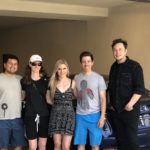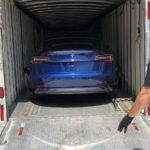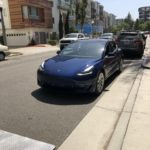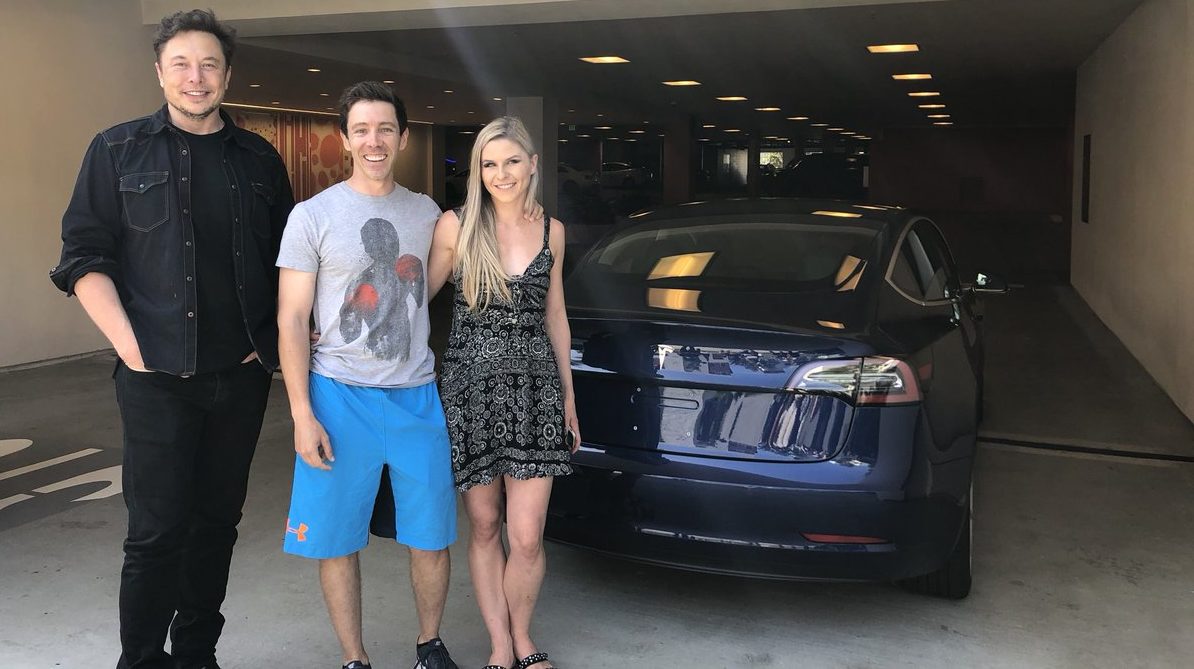
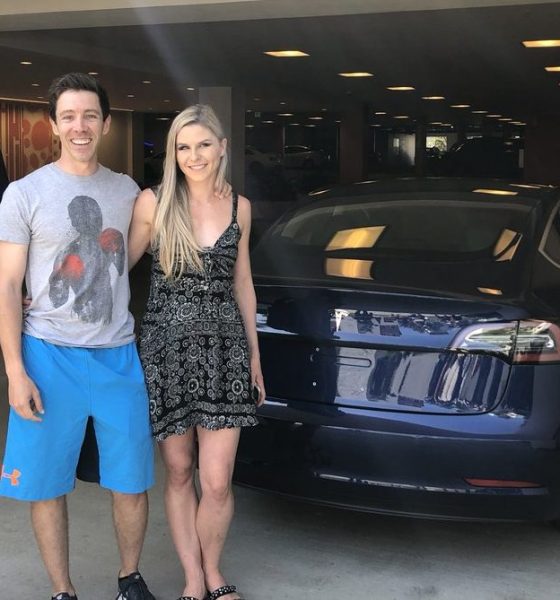
Investor's Corner
Elon Musk delivers Tesla Model 3 to owner’s home in test of factory-direct system
Tesla continues to push new initiatives to get the Model 3 delivered to buyers as efficiently as possible. In a recent announcement on Twitter, CEO Elon Musk revealed that the electric car maker has been trying out a new vehicle delivery system that uses enclosed trailers to transport vehicles straight from the factory to owners’ homes. Musk noted that the new delivery system is “super convenient” and a process that ensures vehicles are handed to their owners in pristine condition, despite not having the usual plastic wrap.
The first images of Tesla’s factory-direct delivery system were recently posted online by Devin Scott from Playa Vista, CA, a beachside enclave and tech hub of Los Angeles that’s located roughly 2-miles from the company’s Marina Del Rey delivery center. Scott noted that his vehicle’s delivery became extra special since his Model 3 was delivered by none other than Elon Musk himself.
We tried out a new delivery system using an enclosed trailer straight from factory to owner’s home, so super convenient & car arrives in pristine condition without wasting plastic wrap https://t.co/exNyhb0zOT
— Elon Musk (@elonmusk) July 30, 2018
With Tesla starting to hit its stride with Model 3 production, producing thousands of vehicles per week, the company must ensure that it does not sit on inventory and end up creating a bottleneck in the delivery of these vehicles. Such a bottleneck appeared to have happened last week, when a Tesla owner reported that a family member was stuck in a delivery center for hours waiting for paperwork to be completed. In response, Elon Musk stated that Tesla is looking to eliminate paper contracts completely. Musk also noted that the company is trying to come up with a system where contracts for the vehicles can be signed digitally, allowing customers to get their cars with a simple tap.
- Tesla Model 3 delivery to customers’ homes. [Credit: Devin Scott/Twitter]
- Tesla Model 3 delivery to customers’ homes. [Credit: Devin Scott/Twitter]
- Tesla Model 3 delivery to customers’ homes. [Credit: Devin Scott/Twitter]
- Tesla Model 3 delivery to customers’ homes. [Credit: Devin Scott/Twitter]
Elon Musk personally delivers a Tesla Model 3 to a reservation holder. [Credit: Devin Scott/Twitter]

Earlier in July, Tesla also introduced a 5 Minute “Sign and Drive” system that expedites the delivery process for Model 3 reservation holders. Under the system, reservation holders are advised to study everything they can about the electric car before their delivery date. This way, Tesla’s staff at the delivery center would only need to cover the basic functions of the vehicle before the customer is given the green light to drive away. As Tesla aims to improve its Model 3 production rate to 6,000 vehicles per week, the electric car maker’s capability to deliver as many cars to reservation holders becomes incredibly important.
Tesla is aiming to hit profitability this Q3 2018. In order to accomplish this, the company would have to deliver as many Model 3 as possible to reservation holders. Considering that Tesla sold its 200,000th electric car in the United States this July, the company has also triggered the phase-out period for the $7,500 federal tax credit granted to buyers of new electric cars. With these factors considered, Tesla would likely push for as many deliveries as it can for the remainder of the year and into early 2019.

Investor's Corner
Tesla stock closes at all-time high on heels of Robotaxi progress

Tesla stock (NASDAQ: TSLA) closed at an all-time high on Tuesday, jumping over 3 percent during the day and finishing at $489.88.
The price beats the previous record close, which was $479.86.
Shares have had a crazy year, dipping more than 40 percent from the start of the year. The stock then started to recover once again around late April, when its price started to climb back up from the low $200 level.
This week, Tesla started to climb toward its highest levels ever, as it was revealed on Sunday that the company was testing driverless Robotaxis in Austin. The spike in value pushed the company’s valuation to $1.63 trillion.
Tesla Robotaxi goes driverless as Musk confirms Safety Monitor removal testing
It is the seventh-most valuable company on the market currently, trailing Nvidia, Apple, Alphabet (Google), Microsoft, Amazon, and Meta.
Shares closed up $14.57 today, up over 3 percent.
The stock has gone through a lot this year, as previously mentioned. Shares tumbled in Q1 due to CEO Elon Musk’s involvement with the Department of Government Efficiency (DOGE), which pulled his attention away from his companies and left a major overhang on their valuations.
However, things started to rebound halfway through the year, and as the government started to phase out the $7,500 tax credit, demand spiked as consumers tried to take advantage of it.
Q3 deliveries were the highest in company history, and Tesla responded to the loss of the tax credit with the launch of the Model 3 and Model Y Standard.
Additionally, analysts have announced high expectations this week for the company on Wall Street as Robotaxi continues to be the focus. With autonomy within Tesla’s sights, things are moving in the direction of Robotaxi being a major catalyst for growth on the Street in the coming year.
Elon Musk
Tesla needs to come through on this one Robotaxi metric, analyst says
“We think the key focus from here will be how fast Tesla can scale driverless operations (including if Tesla’s approach to software/hardware allows it to scale significantly faster than competitors, as the company has argued), and on profitability.”

Tesla needs to come through on this one Robotaxi metric, Mark Delaney of Goldman Sachs says.
Tesla is in the process of rolling out its Robotaxi platform to areas outside of Austin and the California Bay Area. It has plans to launch in five additional cities, including Houston, Dallas, Miami, Las Vegas, and Phoenix.
However, the company’s expansion is not what the focus needs to be, according to Delaney. It’s the speed of deployment.
The analyst said:
“We think the key focus from here will be how fast Tesla can scale driverless operations (including if Tesla’s approach to software/hardware allows it to scale significantly faster than competitors, as the company has argued), and on profitability.”
Profitability will come as the Robotaxi fleet expands. Making that money will be dependent on when Tesla can initiate rides in more areas, giving more customers access to the program.
There are some additional things that the company needs to make happen ahead of the major Robotaxi expansion, one of those things is launching driverless rides in Austin, the first city in which it launched the program.
This week, Tesla started testing driverless Robotaxi rides in Austin, as two different Model Y units were spotted with no occupants, a huge step in the company’s plans for the ride-sharing platform.
Tesla Robotaxi goes driverless as Musk confirms Safety Monitor removal testing
CEO Elon Musk has been hoping to remove Safety Monitors from Robotaxis in Austin for several months, first mentioning the plan to have them out by the end of 2025 in September. He confirmed on Sunday that Tesla had officially removed vehicle occupants and started testing truly unsupervised rides.
Although Safety Monitors in Austin have been sitting in the passenger’s seat, they have still had the ability to override things in case of an emergency. After all, the ultimate goal was safety and avoiding any accidents or injuries.
Goldman Sachs reiterated its ‘Neutral’ rating and its $400 price target. Delaney said, “Tesla is making progress with its autonomous technology,” and recent developments make it evident that this is true.
Investor's Corner
Tesla gets bold Robotaxi prediction from Wall Street firm
Last week, Andrew Percoco took over Tesla analysis for Morgan Stanley from Adam Jonas, who covered the stock for years. Percoco seems to be less optimistic and bullish on Tesla shares, while still being fair and balanced in his analysis.

Tesla (NASDAQ: TSLA) received a bold Robotaxi prediction from Morgan Stanley, which anticipates a dramatic increase in the size of the company’s autonomous ride-hailing suite in the coming years.
Last week, Andrew Percoco took over Tesla analysis for Morgan Stanley from Adam Jonas, who covered the stock for years. Percoco seems to be less optimistic and bullish on Tesla shares, while still being fair and balanced in his analysis.
Percoco dug into the Robotaxi fleet and its expansion in the coming years in his latest note, released on Tuesday. The firm expects Tesla to increase the Robotaxi fleet size to 1,000 vehicles in 2026. However, that’s small-scale compared to what they expect from Tesla in a decade.
Tesla expands Robotaxi app access once again, this time on a global scale
By 2035, Morgan Stanley believes there will be one million Robotaxis on the road across multiple cities, a major jump and a considerable fleet size. We assume this means the fleet of vehicles Tesla will operate internally, and not including passenger-owned vehicles that could be added through software updates.
He also listed three specific catalysts that investors should pay attention to, as these will represent the company being on track to achieve its Robotaxi dreams:
- Opening Robotaxi to the public without a Safety Monitor. Timing is unclear, but it appears that Tesla is getting closer by the day.
- Improvement in safety metrics without the Safety Monitor. Tesla’s ability to improve its safety metrics as it scales miles driven without the Safety Monitor is imperative as it looks to scale in new states and cities in 2026.
- Cybercab start of production, targeted for April 2026. Tesla’s Cybercab is a purpose-built vehicle (no steering wheel or pedals, only two seats) that is expected to be produced through its state-of-the-art unboxed manufacturing process, offering further cost reductions and thus accelerating adoption over time.
Robotaxi stands to be one of Tesla’s most significant revenue contributors, especially as the company plans to continue expanding its ride-hailing service across the world in the coming years.
Its current deployment strategy is controlled and conservative to avoid any drastic and potentially program-ruining incidents.
So far, the program, which is active in Austin and the California Bay Area, has been widely successful.

